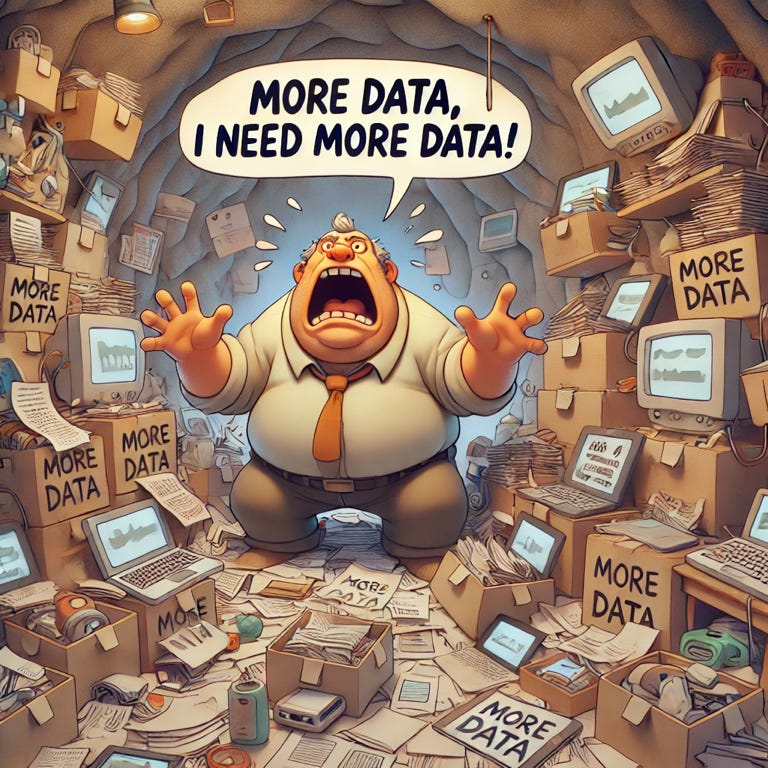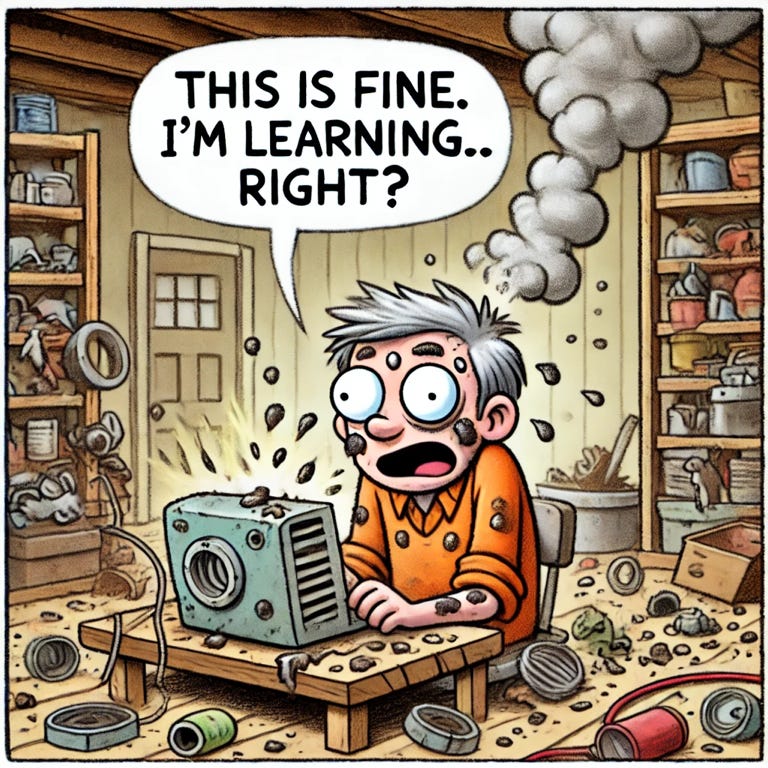After a long hiatus, I feel inspired to write and share my thoughts once again. Hope you enjoy!
As November approaches, many of us are going through annual planning — what are our major initiatives and how are we positioned to execute on them? Among this lies the need to accelerate our progress in data and AI, especially with breakneck development and the possibility of AGI coming within just another year! (See posts from Sam Altman and Dario Amodei).
Let’s pause first and define ‘AGI’ that could come soon. There are lots of definitions floating around, but this is one of my favorites from Dario Amodei. He breaks down what he’s renamed as ‘powerful AI’ with the following characteristics:
Smarter than a Nobel Prize winner in several fields
Receives and executes tasks in multiple ways (audio, video, mouse, chat, etc) and performs them with a skill exceeding most people
It can perform complex tasks over the course of days and weeks
In short, Dario calls this “a country of geniuses in a datacenter”
Powerful AI is like a country of geniuses in a datacenter. It will be smarter than a nobel prize winner and can perform complex tasks in various ways with a high level of skill
With meaningful advancements coming on a scale of thousands of days, it’s imperative for every company to develop a meaningful data and AI strategy of their own. Now is the time to brainstorm, socialize, and staff a multi-year data & AI strategy.
As your teams begin building your strategies, you’ll want to cover basics like understanding the technology, preparing your data and setting up governance (as covered by guides like this). Beyond the table stakes, I’ve been thinking through some additional items to incorporate as your teams build your strategies:
Collect and organize more data, both internal and external
Make proper platform investments in data and AI technologies
Rapid experimentation with AI to build your expertise
Expand your data vault
AI models and LLMs are effectively platforms that perform complex tasks based on the data they’re given. As such, the single biggest differentiator your company can have in the AI era is the proprietary data within your walls. What information about your business, your customers, and the market is unique to you? Identifying that data and growing its base is the most important cornerstone of your long-term AI strategy.
The single biggest differentiator your company can have in the AI era is the data within your walls. What information about your business, your customers, and the market is unique to you?
External data - your customers
Your external data, what you know about your customers (first party) and the market (second and third party) are the main building blocks for delivering a superior and more personalized experience for your customers.
If your team hasn’t yet built a robust CDP (customer data platform) with all the most important facets about your customers, this must be one of your top priorities. Not only will this help your company run its business better today via analytics and personalization, it will be critical context that your AI models will need in order to improve your user experience. Here, focus on your fundamentals like having a modern data warehouse in place, building your core tables, and identifying your top metrics and dimensions.
If your team has a CDP in place, now is the time to expand your footprint. What can you build to collect more data about your customers? Can you create a growth loop that incentivizes your users to continue generating more data?
For example, let’s say you’re a fintech company and you want to know more about your customers. What can you build to collect information about their financial ambitions and how they think about saving? Are there innovative solutions beyond a “goal setting feature” that can hook your users to start cataloging their desires? This is the type of data that will provide invaluable as your company enters the AI era.
Internal data - your company
Maintaining your internal data in the vault is equally as important; this is the data that will enable you to run a more efficient business. This is also some of the data that is often overlooked in favor of developing CDPs. Make sure your company is collecting, storing, and organizing all the critical information on how you run things; go through each department… sales, marketing, product/engineering/design, operations, risk, and more.
Look for pockets of data (sales calls, confluence docs, trainings, etc) that can be utilized to train and improve AI models in ways that drive operational efficiencies.
For example, the data from all your sales calls tagged with which ones of them exemplify good outcomes versus bad outcomes are valuable data source for your AI models to help train your sales reps.
In the next year, it will be critical for your business to have a good map of where your internal data lives, how to access it, and how your team can feed it into AI models for any new projects.
Invest in your data & AI platform
As we enter 2025, let’s hope that most of us have already migrated to the current generation of data technologies, using cloud data warehouses (Snowflake, BigQuery, etc) , orchestration frameworks (airflow, dbt), ETL/ELT tools (Fivetran, Hightouch, HEVO, etc), and quality frameworks (Monte Carlo, great expectations, etc).
LLMs and the newest AI models work differently and we’re already seeing an explosion of new technologies and frameworks to help your teams make the most of them. As such, your 2025 strategy needs to take some of these new technologies into consideration — how to interface with RAGs, vectorDBs, knowledge graphs, and more. These critical platform pieces that will help you store, retrieve and update data that feeds your AI models and AI-powered applications. Without them, your team will be stuck in the “whitelabeling chatGPT” version of AI products.
Consider where and how you’re investing in AI technologies like RAGs, vectorDBs and knowledge graphs
Amir Behbehani has a fantastic breakdown of the the evolving AI stack, which is a must read for any technologist looking to understand how they’ll build their AI applications in the future.
Product experiments with AI
AI is a nascent field, similar to what mobile was in 2008. There will be an inevitable explosion of new design paradigms, use cases, and products that come from this next wave of innovation.
For now, the single best thing we can do is test, iterate, and build our expertise around AI. This is not the time to hang your business on a single AI bet. It’s the time to identify your top product managers and engineers and give them space to explore what can be done with AI. Teams that experiment now will build lasting expertise and gain a long-term advantage with AI.
This is not the time to hang your business on a single AI bet. It’s the time to identify your top product managers and engineers and give them space to explore what can be done with AI.
As you construct your strategies, consider the following:
Calibrate your risk appetite
We’ve all had experimental initiatives laden with pressure and expectations from across the business that crumble with all the attention and stall with too many cooks in the kitchen. Do not let this happen to your AI initiatives!!
By now, most people have heard of the raging success from Google’s Notebook LM. To me, the most important line in their entire announcement is this one:
NotebookLM is an experimental product, built by a small team in Google Labs.
Meaningful discoveries are made from experiments, with small teams, and quarantined away from risk-averse business agendas. As you assemble teams to take bets in AI, make sure they have the space to try lots of different things. Hold them responsible by asking about their learnings and how they’re iterating. And make sure that senior leadership is on the same page about taking these risks!
Experiment, iterate, and learn
In the same spirit of experimentation, the treasure to be discovered in the AI gold rush comes from iterative learning. Each experiment gives you valuable lessons about how the technology works (or doesn’t work), what your customers care about, and how to make adjustments going forward.
For example, let’s say you’re building an LLM to train your sales team better and you’ve thrown every recorded demo from the last 2 years at your model. After your first iteration, you realize that your sales team is getting worse! Upon deeper digging, your team recognizes that you need to label your training data with good demos versus bad demos. You also need to fine tune the model to help teach sales tactics, not share product information, since your product stats have changed in the last 2 years. Getting to this insight quickly helps your team uncover nuances in how to deploy AI and generate value.
Teams that are able to close the feedback loop quickly will learn many times faster than others. This is the time to move fast and train things.
Wrapping up
Now is the time to really get deep about what you need to build in 2025 to be ready for accelerations in AI development. It’s the time to go a level deeper than your competitors to think through the nuances and build them into your multi-year strategic plan. Start investing now in your data and AI strategy. Every step you take today compounds tomorrow when AI takes off. Let’s build together.
Anything catch your eye or just want to chat some more? Please reach out!




